
Beetles are insects that form the order Coleoptera, in the superorder Holometabola. Their front pair of wings are hardened into wing-cases, elytra, distinguishing them from most other insects. The Coleoptera, with about 400,000 described species, is the largest of all orders, constituting almost 40% of described insects and 25% of all known animal species; new species are discovered frequently, with estimates suggesting that there are between 0.9 and 2.1 million total species. Found in almost every habitat except the sea and the polar regions, they interact with their ecosystems in several ways: beetles often feed on plants and fungi, break down animal and plant debris, and eat other invertebrates. Some species are serious agricultural pests, such as the Colorado potato beetle, while others such as Coccinellidae eat aphids, scale insects, thrips, and other plant-sucking insects that damage crops.

Harmonia axyridis is a large lady beetle or ladybug species that is most commonly known as the harlequin, Asian, or multicoloured Asian lady beetle. This is one of the most variable species in the world, with an exceptionally wide range of colour forms. It is native to eastern Asia, but has been artificially introduced to North America and Europe to control aphids and scale insects. It is now common, well known, and spreading in those regions, and has also established in Africa and widely across South America. This species is conspicuous in North America, where it may locally be known as the Halloween beetle, as it often invades homes during October to overwinter.

Buprestidae is a family of beetles known as jewel beetles or metallic wood-boring beetles because of their glossy iridescent colors. Larvae of this family are known as flatheaded borers. The family is among the largest of the beetles, with some 15,500 species known in 775 genera. In addition, almost 100 fossil species have been described.

Adalia bipunctata, the two-spot ladybird, two-spotted ladybug or two-spotted lady beetle, is a carnivorous beetle of the family Coccinellidae that is found throughout the holarctic region. It is very common in western and central Europe. It is also native to North America but it has heavily declined in many states and provinces. It is commonly introduced and imported as a biological control agent.
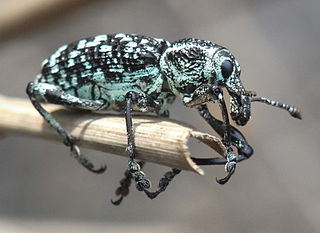
Chrysolopus spectabilis is a species of weevil found in south-eastern Australia. It was discovered during James Cook's first voyage, and became one of the first insects to be described from Australia. The weevil measures up to 25 mm (1.0 in) long and includes distinctive metallic green and black scales. It is found only on 28 species of the plant genus Acacia.

Arthroleptis variabilis is a species of frog in the family Arthroleptidae. It is found in the lowlands of eastern Nigeria, Cameroon, Equatorial Guinea, Gabon, the Central African Republic, the Republic of the Congo, and the Democratic Republic of the Congo. Earlier records west from Nigeria refer to other species, including Arthroleptis krokosua described in 2008. Common names Buea screeching frog and variable squeaker frog have been coined for it.

Angophora hispida grows as a mallee, or as a tree to about 7 m (25 ft) in height. A. hispida's small size, especially when compared to its Angophora and Eucalyptus relatives, leads to it being known by the common name dwarf apple. It is native to a relatively small patch of central New South Wales – from just south of Sydney up to the Gosford area. The plant's leaves are sessile (stalk-less) and hug the stem with heart-shaped bases. Its previous name – A. cordifolia – referred to these cordate leaves. Another distinctive feature are the red bristly hairs that cover the branchlets, flower bases and new growth. This leads to the specific epithet hispida.
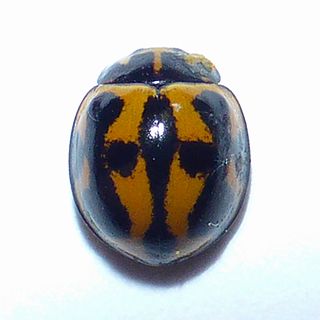
Coelophora inaequalis, the variable ladybird, common Australian lady beetle or common Australian ladybug is a ladybird species endemic to Australia, Oceania and Southern Asia. The variable ladybird gets its name from the black markings on the adult elytra, that vary from one individual to another.

Coraebus rubi is a species of jewel beetles belonging to the family Buprestidae, subfamily Agrilinae.
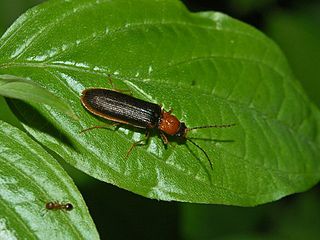
Denticollis linearis is a species of click beetle belonging to the family Elateridae subfamily Dendrometrinae.

Temognatha is a genus of metallic wood-boring beetles. Over 85 species in the genus are native to Australia.
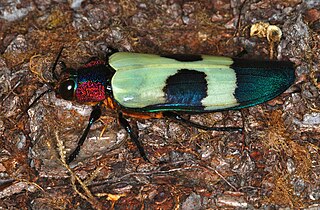
Chrysochroa buqueti, the red speckled jewel beetle, is a Southeast Asian species of beetle in the Buprestidae family and tribe Chrysochroini.
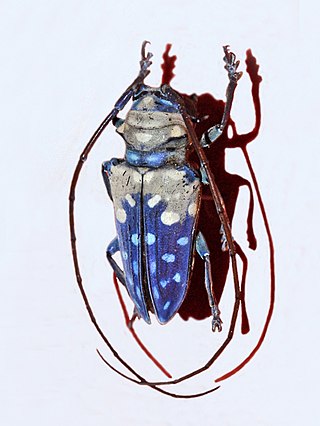
Sternotomis variabilis, the Lesser Jewel Longhorn Beetle, is a species of flat-faced longhorn beetles belonging to the family Cerambycidae.

Sternocera orissa, the giant jewel beetle, is a species of beetles belonging to the Buprestidae family.
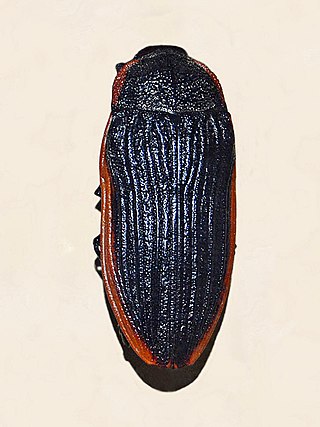
Temognatha grandis is a species of beetles belonging to the family Buprestidae.
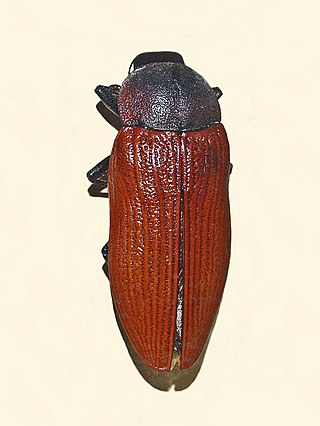
Temognatha heros, the Yellow Jewel Beetle or Large Jewel Beetle, is a species of beetles belonging to the family Buprestidae.

Melanophila acuminata, known generally as the black fire beetle or fire bug, is a species of metallic wood-boring beetle in the family Buprestidae. It is found in the Caribbean, Europe and Northern Asia, Central America, North America, and Southern Asia. They get their common name due to the fact that they swarm freshly burned conifer trees, which they find using sensors on their thorax. Adults are black and 7–11 mm in length.

Mylabris variabilis is a species of blister beetle belonging to the Meloidae family.
Temognatha aestimata is a jewel beetle in the family Buprestidae, found in Victoria. It was first described in 1898 by Charles Kerremans as Stigmodera aestimata.
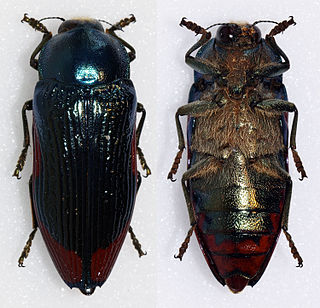
Temognatha miranda is a jewel beetle in the family Buprestidae, found in Western Australia. It was first described in 1927 by Herbert James Carter as Stigmodera miranda.




















